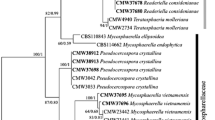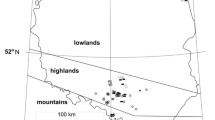Abstract
Lyophyllum shimeji is an edible ectomycorrhizal fungus that is widely distributed in East Asia and also present in the northern regions of Europe. In Japan, L. shimeji is a culinary delicacy, considered amongst all edible mushrooms to have the best taste and to be second only to Tricholoma matsutake in price. Traditionally, fruiting bodies of L. shimeji have been collected from the wild but fruiting of L. shimeji is now relatively uncommon and cannot keep up with increasing consumer demand. As a result, methods for its cultivation are being developed for commercial production in Japan and other countries. In this work, techniques were developed to cultivate L. shimeji on coniferous seedlings using a pure culture inoculum. They resulted in successful mycorrhization of Pinus pinaster and Picea abies in only 8 to 10 months. As ectomycorrhizae of L. shimeji are difficult to identify morphologically, mycorrhization was confirmed using an L. shimeji-specific PCR diagnostic, which was designed following a phylogenetic analysis of the Lyophyllum section Difformia using DNA sequences of the internal transcribed spacer (ITS), intergenic spacer (IGS) and elongation factor 1-α (EF1-α) gene. L. shimeji is a member of the Lyophyllum decastes complex in section Difformia, which also includes Lyophyllum fumosum and L. decastes. This analysis confirmed the separation of L. shimeji from closely related Lyophyllum spp. and enabled its unambiguous detection using an IGS-based PCR diagnostic. This is the first report of successful mycorrhization of L. shimeji on P. pinaster and P. abies and provides an opportunity for its commercial cultivation on conifers in New Zealand.






Similar content being viewed by others
References
Agerer R (1988) Studies on ectomycorrhizae. XVII: the ontogeny of the ectomycorrhizal rhizomorphs of Paxillus involutus and Thelephora terrestris (Basidiomycetes). Nova Hedwig Kryptogamen 47:311–334
Amicucci A, Zambonelli A, Giomaro G, Potenza L, Stocchi V (1998) Identification of ectomycorrhizal fungi of the genus Tuber by species specific ITS primers. Mol Ecol 7:273–277
Anderson JB, Stasovski E (1992) Molecular phylogeny of Northern-Hemisphere species of Armillaria. Mycologia 84:505–516. doi:10.2307/3760315
Benucci GMN, Bonito G, Falini LB, Bencivenga M (2011) Mycorrhization of pecan trees (Carya illinoinensis) with commercial truffle species: Tuber aestivum Vittad. and Tuber borchii Vittad. Mycorrhiza 22:383–392. doi:10.1007/s00572-011-0413-z
Biomatters Ltd. (2011) Geneious v5.3.4. http://www.geneious.com
Bruns TD, White TJ, Taylor JW (1991) Fungal molecular systematics. Annu Rev Ecol Syst 22:525–564. doi:10.1146/annurev.es.22.110191.002521
Clémençon H, Moncalvo J (1990) Taxonomic analysis of cultural characters in the group Lyophyllum shimeji (Agaricales, Basidiomycetes) from Japan. Trans Mycol Soc Jpn 31:479–488
Clémençon H, Smith AH (1983) New species of Lyophyllum (Agaricales) from North America and a key to the known staining species. Mycotaxon 18:379–437
Douet J, Castroviejo M, Mabru D, Chevalier G, Dupré C, Bergougnoux F, Ricard J, Médina B (2004) Rapid molecular typing of Tuber melanosporum, T. brumale and T. indicum from tree seedlings and canned truffles. Anal Bioanal Chem 379:668–673
Duchesne LC, Anderson JB (1990) Location and direction of transcription of the 5 s ribosomal-RNA gene in Armillaria. Mycol Res 94:266–269
Edgar RC (2004) MUSCLE: multiple sequence alignment with high accuracy and high throughput. Nucleic Acids Res 32:1792–1797. doi:10.1093/nar/gkh340
Fujita H (1992) 11.Honshimeji mushroom (in Japanese). In: The newest biotechnology complete works editorial board meeting. Growth and the breeding of mushrooms. Nougyou-tosho Co, Ltd., Tokyo, Japan, pp 300–307
Guerin-Laguette A (2008) La trufficulture en Nouvelle-Zélande: 20 ans déjà. [The truffle cultivation in New Zealand: 20 years already]. In: INRA, Le Causse Corrézien (eds) Proceedings of the international conference ‘La culture de la truffe dans le monde’ [The truffle cultivation in the world], Brive-la-Gaillarde, France, 2 February 2007, pp 151–162
Guerin-Laguette A, Plassard C, Mousain D (2000a) Effects of experimental conditions on mycorrhizal relationships between Pinus sylvestris and Lactarius deliciosus and unprecedented fruit-body formation of the Saffron milk cap under controlled soilless conditions. Can J Microbiol 46:790–799
Guerin-Laguette A, Vaario L-M, Gill W, Lapeyrie F, Matsushita N, Suzuki K (2000b) Rapid in vitro ectomycorrhizal infection on Pinus densiflora roots by Tricholoma matsutake. Mycoscience 41:389–393. doi:10.1007/bf02463952
Hall I, Wang Y (2002) Truffles and other edible mycorrhizal mushrooms-some new crops for the Southern Hemisfer. In: Edible mycorrhizal mushrooms and their cultivation. Proceedings of the 2nd international conference on edible mushrooms, Christchurch, New Zealand, 3–6 July 2001 (CD-ROM)
Hofstetter V, Clemençon H, Vilgalys R, Moncalvo JM (2002) Phylogenetic analyses of the Lyophylleae (Agaricales, Basidiomycota) based on nuclear and mitochondrial rDNA sequences. Mycol Res 106:1043–1059. doi:10.1017/s095375620200641x
Hongo T (1990) Mycorrhizal Agaricales (in Japanese). Trans Mycol Soc Jpn 31:281–286
Kawai M (1997) Artificial ectomycorrhiza formation on roots of air-layered Pinus densiflora saplings by inoculation with Lyophyllum shimeji. Mycologia 89:228–232
Kosaka H, Aikawa T, Ogura N, Tabata K, Kiyohara T (2001) Pine wilt disease caused by the pine wood nematode: the induced resistance of pine trees by the avirulent isolates of nematode. Eur J Plant Pathol 107:667–675. doi:10.1023/a:1011954828685
Larsson E, Sundberg H (2011) Lyophyllum shimeji, a species associated with lichen pine forest in northern Fennoscandia. Mycoscience 52:289–295. doi:10.1007/s10267-010-0104-1
Liedeker H, Schütt P, Klein RM (1988) Symptoms of forest decline (Waldsterben) on Norway and red spruce. Eur J For Pathol 18:13–25. doi:10.1111/j.1439-0329.1988.tb00749.x
Maeta K, Koike A, Mukaiyama H, Ochi T, Terashita T, Kitamoto Y, Aimi T (2008) Preparation and crossing of mating-capable monokaryons via protoplasting of the dikaryotic mycelia of a mycorrhizal mushroom, Lyophyllum shimeji. J Wood Sci 54:337–340. doi:10.1007/s10086-008-0949-5
Moncalvo JM (1992) Ribosomal DNA and systematics of fungi: the section Difformia of the genus Lyophyllum as an example. In: Role of fungi as frontiers of biosciences: proceedings of the Asian Mycological Society, Seoul, South Korea, pp 208–219
Moncalvo JM, Clémençon H (1994) Enzymatic studies as an aid to the taxonomy of the Lyophyllum decastes complex. Mycol Res 98:375–383
Moncalvo JM, Rehner SA, Vilgalys R (1993) Systematics of Lyophyllum section Difformia based on evidence from culture studies and ribosomal DNA-sequences. Mycologia 85:788–794
Nylund J, Wallander H (1989) Effects of ectomycorrhiza on host growth and carbon balance in a semi-hydroponic cultivation system. New Phytol 112:389–398
Ohta A (1994a) Production of fruit-bodies of a mycorrhizal fungus, Lyophyllum shimeji, in pure culture. Mycoscience 35:147–151
Ohta A (1994b) Some cultural characteristics of mycelia of a mycorrhizal fungus, Lyophyllum shimeji. Mycoscience 35:83–87
Ohta A (1998) Mass-production of fruit-bodies of Lyophyllum shimeji without host plant. Nippon Kingakukai Kaiho 39:121–124
Paolocci F, Rubini A, Granetti B, Arcioni S (1999) Rapid molecular approach for a reliable identification of Tuber spp. ectomycorrhizae. FEMS Microbiol Ecol 28:23–30
Parladé J, Pera J, Alvarez IF (1996) Inoculation of containerized Pseudotsuga menziesii and Pinus pinaster seedlings with spores of five species of ectomycorrhizal fungi. Mycorrhiza 6:237–245. doi:10.1007/s005720050131
Pera J, Alvarez I (1995) Ectomycorrhizal fungi of Pinus pinaster. Mycorrhiza 5:193–200. doi:10.1007/bf00203337
Poitou N, Mamoun M, Ducamp M, Guinberteau J, Olivier JM (1989) Controlled mycorrhization and experimental cultivation in the field of Boletus (=Suillus) granulatus and Lactarius deliciosus. Mushroom Sci 12:551–564
Rehner SA, Buckley E (2005) A Beauveria phylogeny inferred from nuclear ITS and EF1-α sequences: evidence for cryptic diversification and links to Cordyceps teleomorphs. Mycologia 97:84–98. doi:10.3852/mycologia.97.1.84
Singer R (1975) The Agaricales in modern taxonomy. Cramer, Vaduz
Tamura K, Dudley J, Nei M, Kumar S (2007) MEGA4: Molecular Evolutionary Genetics Analysis (MEGA) software version 4.0. Mol Biol Evol 24:1596–1599. doi:10.1093/molbev/msm092
Visnovsky SB, Guerin-Laguette A, Wang Y, Pitman AR (2010) Traceability of marketable Japanese Shoro in New Zealand: using multiplex PCR to exploit phylogeographic variation among taxa in the Rhizopogon Subgenus Roseoli. Appl Environ Microbiol 76:294
Wang Y, Cummings N, Guerin-Laguette A (2013) Cultivation of Basidiomycete edible ectomycorrhizal mushrooms: Tricholoma, Lactarius, and Rhizopogon. In: Zambonelli A, Bonito GM (eds) Edible ectomycorrhizal mushrooms. Springer, Berlin, pp 281–304. doi:10.1007/978-3-642-33823-6_16
Wang Y, Hall IR, Dixon M, Hance-Halloy M, Strong G, Brass P (2002) The cultivation of Lactarius deliciosus (saffron milk cap) and Rhizopogon rubescens (shoro) in New Zealand. In: Proceedings of the second international conference on edible mycorrhizal mushrooms, Christchurch, New Zealand, 3–6 July 2001.
White T, Bruns T, Lee S, Taylor J, Innis M, Gelfand D, Sninsky J (1990) PCR protocols: a guide to methods and applications. PCR protocols: a guide to methods and applications. Academic, New York
Yamada A, Katsuya K (1995) Mycorrhizal association of isolates from sporocarps and ectomycorrhizas with Pinus densiflora seedlings. Mycoscience 36:315–323. doi:10.1007/BF02268607
Yamada A, Masuno K, Fukuda M (2012) Taxonomic considerations for Japanese Lyophyllum shimeji and its allied species. Mushroom Scie Biotechnol 20:9–15 (in Japanese)
Yamada A, Ogura T, Ohmasa M (2001a) Cultivation of mushrooms of edible ectomycorrhizal fungi associated with Pinus densiflora by in vitro mycorrhizal synthesis I. Primordium and basidiocarp formation in open-pot culture. Mycorrhiza 11:59–66
Yamada A, Ogura T, Ohmasa M (2001b) Cultivation of mushrooms of edible ectomycorrhizal fungi associated with Pinus densiflora by in vitro mycorrhizal synthesis II. Morphology of mycorrhizas in open-pot soil. Mycorrhiza 11:67–81
Yamanaka K (2008) Commercial cultivation of Lyophyllum shimeji. In: Proceedings of the sixth international conference on mushroom biology and mushroom products, Bonn, Germany, 29 September–3 October. pp 197–202
Yun W, Hall IR (2004) Edible ectomycorrhizal mushrooms: challenges and achievements. Can J Bot 82:1063–1073
Acknowledgments
The authors thank Mr Naoki Endo and Mr Keiichi Okada for their help in the field sampling of Honshimeji basidiomata and Simon Bulman for his review of the manuscript. This work was funded by New Zealand’s Foundation for Research, Science & Technology through contract C02X0704, by The New Zealand Institute for Plant & Food Research Limited and by First Light Mushroom Co. Ltd., Gisborne, New Zealand.
Author information
Authors and Affiliations
Corresponding author
Electronic supplementary material
Below is the link to the electronic supplementary material.
Supplementary Fig. 1
Nucleotide sequence alignment of the consensus DNA sequences for the IGS from L. shimeji, L. fumosum and L. decastes. The alignment shows the location of the primers ShIGSF1 (green arrow) and ShIGSR2 (orange arrow) designed for the specific detection of “Honshimeji” using Geneious Pro v5.3.4 (Biomatters Ltd. 2011). Coloured squares show polymorphic nucleotides on the divergent consensus sequence. A dash represents a missing nucleotide in the associated IGS sequence. The primers were designed to amplify a 345-bp fragment from L. shimeji (PPTX 488 kb)
Supplementary Table S1
Collections of Lyophyllum from this study and the GenBank accession numbers for the respective ITS, IGS and EF1-α DNA sequences (DOCX 18 kb)
Supplementary Table S2
DNA sequences of Lyophyllum retrieved from GenBank used in this study (DOCX 25 kb)
Rights and permissions
About this article
Cite this article
Visnovsky, S.B., Cummings, N., Guerin-Laguette, A. et al. Detection of the edible ectomycorrhizal fungus Lyophyllum shimeji colonising seedlings of cultivated conifer species in New Zealand. Mycorrhiza 24, 453–463 (2014). https://doi.org/10.1007/s00572-013-0552-5
Received:
Accepted:
Published:
Issue Date:
DOI: https://doi.org/10.1007/s00572-013-0552-5




